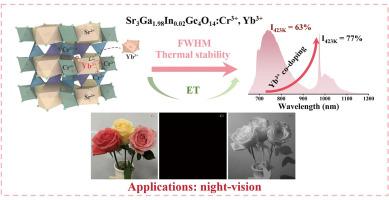通过高效能量转移提高 Sr3Ga1.98In0.02Ge4O14:0.03Cr3+ 的热稳定性和发光性能
IF 3.3
3区 物理与天体物理
Q2 OPTICS
引用次数: 0
摘要
在这项工作中,为了探索近红外荧光粉转换发光二极管(pc-LEDs),采用高温固态方法实现了近红外荧光粉 Sr3Ga1.98In0.02Ge4O14:0.03Cr3+, 0.05 Yb3+,由于从 Cr3+ 到 Yb3+ 的能量转移,该荧光粉呈现出宽带发射,半最大全宽(FWHM)达到 291 nm。Sr3Ga1.98In0.02Ge4O14:0.03Cr3+, 0.05Yb3+ 的发射强度(423 K 时)可保持在室温的 77%,比未共掺杂之前高出 14%,表明这种荧光粉具有更好的热稳定性。通过将 Sr3Ga1.98In0.02Ge4O14:0.03Cr3+, 0.05 Yb3+ 荧光粉与蓝光 LED 结合,可以制造出近红外 pc-LED,应用于夜视领域。结果证明了其潜在的应用价值。本文章由计算机程序翻译,如有差异,请以英文原文为准。

Improving the thermal stability and luminescence of Sr3Ga1.98In0.02Ge4O14:0.03Cr3+ through the efficient energy transfer
In this work, in order to explore the near-infrared (NIR) phosphor converted light emitting diodes (pc-LEDs), the NIR phosphor Sr3Ga1.98In0.02Ge4O14:0.03Cr3+, 0.05 Yb3+ was achieved by the high temperature solid-state method, which presents a broadband emission with a large full width at half maximum (FWHM) of 291 nm due to the energy transfer from Cr3+ to Yb3+. The emission intensity (at 423 K) of Sr3Ga1.98In0.02Ge4O14:0.03Cr3+, 0.05 Yb3+ can be maintained at 77 % of room temperature, which is 14 % higher than that before co-doping, indicating that this phosphor has better thermal stability. The NIR pc-LEDs can be fabricated by combining the phosphor Sr3Ga1.98In0.02Ge4O14:0.03Cr3+, 0.05 Yb3+ with the blue LED, which can be applied in night vision. The results demonstrated its potential application value.
求助全文
通过发布文献求助,成功后即可免费获取论文全文。
去求助
来源期刊

Journal of Luminescence
物理-光学
CiteScore
6.70
自引率
13.90%
发文量
850
审稿时长
3.8 months
期刊介绍:
The purpose of the Journal of Luminescence is to provide a means of communication between scientists in different disciplines who share a common interest in the electronic excited states of molecular, ionic and covalent systems, whether crystalline, amorphous, or liquid.
We invite original papers and reviews on such subjects as: exciton and polariton dynamics, dynamics of localized excited states, energy and charge transport in ordered and disordered systems, radiative and non-radiative recombination, relaxation processes, vibronic interactions in electronic excited states, photochemistry in condensed systems, excited state resonance, double resonance, spin dynamics, selective excitation spectroscopy, hole burning, coherent processes in excited states, (e.g. coherent optical transients, photon echoes, transient gratings), multiphoton processes, optical bistability, photochromism, and new techniques for the study of excited states. This list is not intended to be exhaustive. Papers in the traditional areas of optical spectroscopy (absorption, MCD, luminescence, Raman scattering) are welcome. Papers on applications (phosphors, scintillators, electro- and cathodo-luminescence, radiography, bioimaging, solar energy, energy conversion, etc.) are also welcome if they present results of scientific, rather than only technological interest. However, papers containing purely theoretical results, not related to phenomena in the excited states, as well as papers using luminescence spectroscopy to perform routine analytical chemistry or biochemistry procedures, are outside the scope of the journal. Some exceptions will be possible at the discretion of the editors.
 求助内容:
求助内容: 应助结果提醒方式:
应助结果提醒方式:


